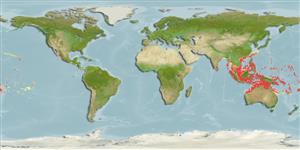Preferred temperature (Ref.
123201): 25.3 - 29, mean 27.9 °C (based on 620 cells).
Phylogenetic diversity index (Ref.
82804): PD
50 = 0.5000 [Uniqueness, from 0.5 = low to 2.0 = high].
Bayesian length-weight: a=0.01349 (0.00618 - 0.02945), b=3.00 (2.81 - 3.19), in cm total length, based on LWR estimates for this (Sub)family-body shape (Ref.
93245).
Nivel trófico (Ref.
69278): 3.4 ±0.45 se; based on food items.
Resiliencia (Ref.
120179): Alto, población duplicada en un tiempo mínimo inferior a 15 meses (Preliminary K or Fecundity.).
Fishing Vulnerability (Ref.
59153): Low vulnerability (10 of 100).
Nutrients (Ref.
124155): Calcium = 64.1 [37.5, 119.4] mg/100g; Iron = 0.731 [0.400, 1.242] mg/100g; Protein = 18 [16, 20] %; Omega3 = 0.18 [0.11, 0.28] g/100g; Selenium = 35.8 [20.3, 68.0] μg/100g; VitaminA = 177 [62, 569] μg/100g; Zinc = 1.3 [0.9, 1.9] mg/100g (wet weight);
